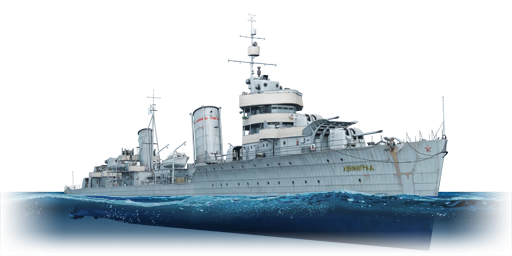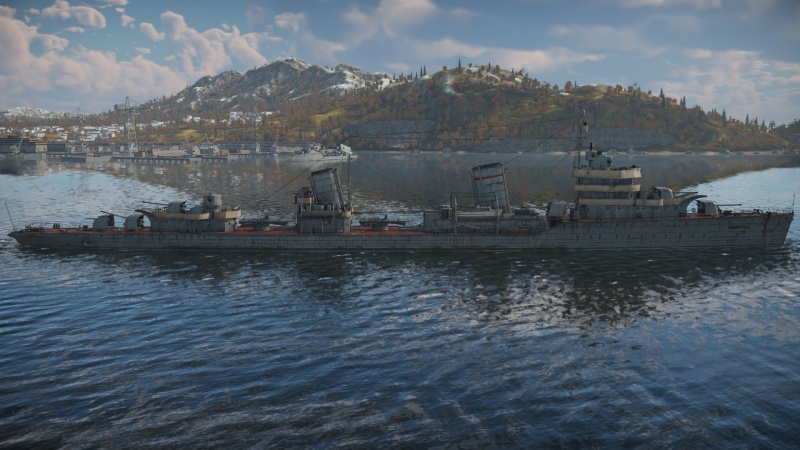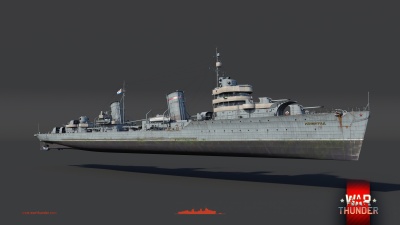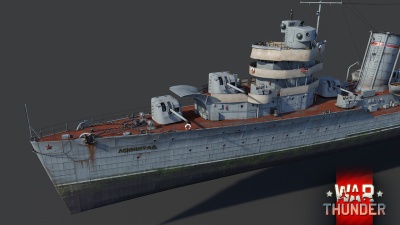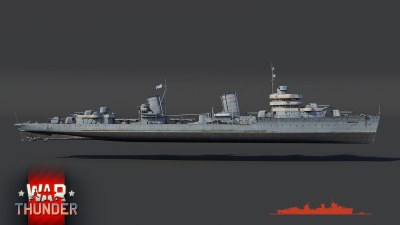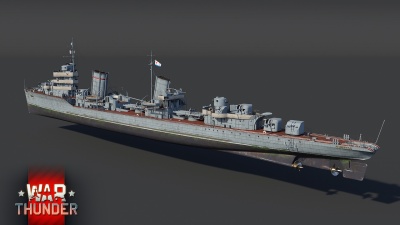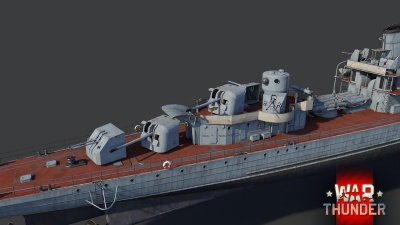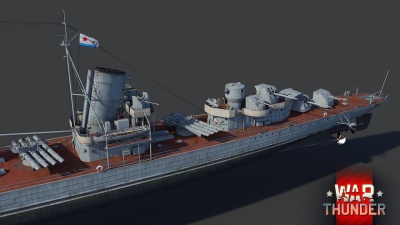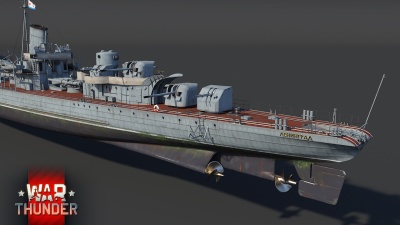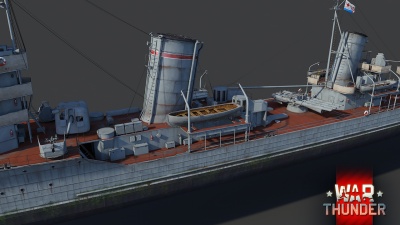Difference between revisions of "Leningrad"
(→Primary armament: added penetration chart) |
Colok76286 (talk | contribs) (→See also: Edits) |
||
| (10 intermediate revisions by 6 users not shown) | |||
| Line 7: | Line 7: | ||
== Description == | == Description == | ||
<!-- ''In the first part of the description, cover the history of the ship's creation and military application. In the second part, tell the reader about using this ship in the game. Add a screenshot: if a beginner player has a hard time remembering vehicles by name, a picture will help them identify the ship in question.'' --> | <!-- ''In the first part of the description, cover the history of the ship's creation and military application. In the second part, tell the reader about using this ship in the game. Add a screenshot: if a beginner player has a hard time remembering vehicles by name, a picture will help them identify the ship in question.'' --> | ||
| − | The '''{{Specs|name}}''' | + | The '''{{Specs|name}}''' was a Soviet Leningrad-class destroyer leader built in the 1930s as the first of six ships. She was laid down on 5th November 1932 and commissioned on 5th December 1936. The design was inspired by the French Vaquelin-class destroyers, as the Soviets wanted to built similar ships on their own. Due to the uneven weight distribution, the ships were top-heavy and had poor seaworthiness in rough seas. After the start of the Winter War on 30th November 1939, Leningrad and her sister Minsk bombarded Finnish positions on Saarenpää Island. She conducted the same mission several times and during these missions, she was badly damaged by the ice and underwent repairs until May 1941. At the end of August 1941, she helped evacuate personnel from Tallinn and then shelled the advancing German troops in the Leningrad area. On 9th November, while en route to Hanko from Kronshtadt, a mine exploded in her paravane, causing heavy damage to her machinery. After the repairs, she resumed performing shore bombardment missions in the Leningrad area before the siege of the city was lifted in 1944. During the 1950s, she underwent modernization. She was reclassified as a training ship in 1958, converted to a floating barracks in 1960, and her hulk used as a target in 1962, during which she sunk. |
| + | |||
| + | Leningrad was introduced during [[Update 1.85 "Supersonic"]] as part of the 2019 [[wt:en/news/6037-event-sea-voyage-en|Sea Voyage]] event. As with all 1930s Soviet designs, Leningrad uses manually traversed turrets causing low traverse speed, making engaging different targets difficult. Another issue shared by nearly all destroyers are the magazines and their placement above waterline without any armour protection often leading to fatal explosion when hit. On the other hand, Leningrad's very high top speed allows her to easily close distance to enemies for torpedo runs with her fast albeit short-ranged torpedoes. | ||
== General info == | == General info == | ||
=== Survivability and armour === | === Survivability and armour === | ||
| − | {{Specs-Fleet-Armour}}<!-- Talk about the vehicle's armour. Note the most well-defended and most vulnerable zones, e.g. the ammo magazine. Evaluate the composition of components and assemblies responsible for movement and manoeuvrability. Evaluate the survivability of the primary and secondary armaments separately. Don't forget to mention the size of the crew, which plays an important role in fleet mechanics. Save tips on preserving survivability for the "Usage in battles" section. If necessary, use a graphical template to show the most well-protected or most vulnerable points in the armour. --> | + | {{Specs-Fleet-Armour}} |
| + | <!-- ''Talk about the vehicle's armour. Note the most well-defended and most vulnerable zones, e.g. the ammo magazine. Evaluate the composition of components and assemblies responsible for movement and manoeuvrability. Evaluate the survivability of the primary and secondary armaments separately. Don't forget to mention the size of the crew, which plays an important role in fleet mechanics. Save tips on preserving survivability for the "Usage in battles" section. If necessary, use a graphical template to show the most well-protected or most vulnerable points in the armour.'' --> | ||
The Leningrad has good survivability for a destroyer. First, it has a very high crew count of 344 crew members. Second, the ship's vital components are primarily located under the waterline making them harder to hit. However, the engine blocks are partially exposed, meaning that this ship can have its engines knocked out quite easily. Each of the five main cannons also have a ready-rack of 20 shells located beside the gun, which can be detonated with accurate fire. As with most destroyers, the Leningrad lacks armour on the hull, the only armour being thin anti-fragmentation armour on the gun turrets. | The Leningrad has good survivability for a destroyer. First, it has a very high crew count of 344 crew members. Second, the ship's vital components are primarily located under the waterline making them harder to hit. However, the engine blocks are partially exposed, meaning that this ship can have its engines knocked out quite easily. Each of the five main cannons also have a ready-rack of 20 shells located beside the gun, which can be detonated with accurate fire. As with most destroyers, the Leningrad lacks armour on the hull, the only armour being thin anti-fragmentation armour on the gun turrets. | ||
=== Mobility === | === Mobility === | ||
| − | {{Specs-Fleet-Mobility}}<!-- Write about the ship's mobility. Evaluate its power and manoeuvrability, rudder rerouting speed, stopping speed at full tilt, with its maximum forward and reverse speed. --> | + | {{Specs-Fleet-Mobility}} |
| − | As with the [[Moskva]], its sister-ship, the Leningrad is extremely mobile. The main highlight of the Leningrad's mobility is its top speed: 80 km/h (43 | + | <!-- ''Write about the ship's mobility. Evaluate its power and manoeuvrability, rudder rerouting speed, stopping speed at full tilt, with its maximum forward and reverse speed.'' --> |
| + | As with the [[Moskva]], its sister-ship, the Leningrad is extremely mobile. The main highlight of the Leningrad's mobility is its top speed: 80 km/h (43 kn) in realistic and 107 km/h in arcade. This destroyer is among the fastest in the game, and can rush to bases faster than any other destroyer. However, Leningrad's acceleration, turning circle and rudder shift are pretty mediocre among ships of its class. | ||
{{NavalMobility}} | {{NavalMobility}} | ||
| Line 34: | Line 38: | ||
The B-13 cannon is shared by most WWII-era destroyers of the Soviet fleet, and is a very potent weapon. However, the main flaw with this weapon is its absolutely horrid turret rotation speed of 4.2 degrees/second vertically and horizontally. This means that you have to turn the turrets very early to be able to engage effectively. The guns themselves shoot accurately and have a high initial velocity (870 m/s compared to 790 m/s for the American 5"/38 guns). However, this comes at the expense of reload speed, as the manually-loaded weapons can only fire at 10 rounds per minute (RPM) with a spaded crew, compared to 22 RPM for the American 5"/38. In fact, this fire rate is slower than everything except for the Japanese and Italian 5" guns, which have a similar fire rate. | The B-13 cannon is shared by most WWII-era destroyers of the Soviet fleet, and is a very potent weapon. However, the main flaw with this weapon is its absolutely horrid turret rotation speed of 4.2 degrees/second vertically and horizontally. This means that you have to turn the turrets very early to be able to engage effectively. The guns themselves shoot accurately and have a high initial velocity (870 m/s compared to 790 m/s for the American 5"/38 guns). However, this comes at the expense of reload speed, as the manually-loaded weapons can only fire at 10 rounds per minute (RPM) with a spaded crew, compared to 22 RPM for the American 5"/38. In fact, this fire rate is slower than everything except for the Japanese and Italian 5" guns, which have a similar fire rate. | ||
| − | The guns themselves have access to three shell types: the OF-46 high-explosive (HE) shell, the PB-46A semi armour-piercing (SAPBC) shell, and the ZS-46R proximity- | + | The guns themselves have access to three shell types: the OF-46 high-explosive (HE) shell, the PB-46A semi armour-piercing (SAPBC) shell, and the ZS-46R proximity-fused (HE-VT) shell. Of these weapons, the HE shell is usually the best against enemy destroyers and ships as it packs the most explosive filler, 3.58 kg of it to be exact. The SAPBC shell works better against the occasional cruiser you may encounter, as it packs more penetration capacity (up to 179 mm compared to 36 mm for the HE shell). Finally, the HE-VT shell is good against aircraft as it will explode when close enough to the enemy aircraft, meaning that it doesn't require a direct hit. However, it actually packs less explosive filler than the normal HE shell, which is unusual for any HE-VT shell. Combined with the horrible traverse rate, this means the guns aren't particularly suited for anti-aircraft duties. |
| − | |||
| − | |||
| − | |||
| − | |||
| − | |||
| − | |||
| − | |||
| − | |||
| − | |||
| − | |||
| − | |||
| − | |||
| − | |||
| − | |||
| − | |||
| − | |||
| − | |||
| − | { | + | {{:B-13 (130 mm)/Ammunition|130 mm OF-46 HE, 130 mm PB-46A SAPBC, 130 mm ZS-46R HE-VT}} |
| − | |||
| − | |||
| − | |||
| − | |||
| − | |||
| − | |||
| − | |||
| − | |||
| − | |||
| − | |||
| − | |||
| − | |||
| − | |||
| − | | 130 mm OF-46 HE | ||
| − | |||
| − | |||
| − | |||
| − | |||
| − | |||
| − | |||
=== Secondary armament === | === Secondary armament === | ||
| Line 82: | Line 49: | ||
The Leningrad carries a secondary armament of four 76 mm (3 inch) 34-K guns in two single mountings and one dual mounting, all placed at the very rear of the vessel. The 34-K is also shared by most WWII-era Soviet ships, and gives you a potent secondary weapon that is of a relatively high calibre. This gun has a high fire rate of 27 rounds per minute (2.2-second reload), which can be decreased to 1.1 seconds with a full crew. The weapon itself is decent at closer ranges, but isn't a particularly effective anti-aircraft weapon as it inherits the extremely weak Soviet traverse rate. The single mountings themselves are only capable of traversing at 10 degrees per second, marginally faster than guns of cruiser calibre (6 inch+) of other nations. | The Leningrad carries a secondary armament of four 76 mm (3 inch) 34-K guns in two single mountings and one dual mounting, all placed at the very rear of the vessel. The 34-K is also shared by most WWII-era Soviet ships, and gives you a potent secondary weapon that is of a relatively high calibre. This gun has a high fire rate of 27 rounds per minute (2.2-second reload), which can be decreased to 1.1 seconds with a full crew. The weapon itself is decent at closer ranges, but isn't a particularly effective anti-aircraft weapon as it inherits the extremely weak Soviet traverse rate. The single mountings themselves are only capable of traversing at 10 degrees per second, marginally faster than guns of cruiser calibre (6 inch+) of other nations. | ||
| − | The gun itself has access to three main shell types - the O-361K high-explosive (HE) shell, the O-361D time- | + | The gun itself has access to three main shell types - the O-361K high-explosive (HE) shell, the O-361D time-fused (HE-TF) shell, and the BR-361 armour-piercing (APHEBC) shell. Of these rounds, the HE is almost always the best against enemy boats as it has the most explosive filler, and consequently, does the most damage. The HE-TF round is slightly worse as it detonates on a timed fuse, meaning the accuracy of the shell depends on crew skills. Finally, the APHEBC shells are rarely usable due to their low damage potential. For good measure, bring mostly HE, and a bit of HE-TF and APHEBC just in case the situation arises. |
| + | |||
| + | {{:34-K (76 mm)/Ammunition|76 mm O-361K, 76 mm O-361D, 76 mm BR-361}} | ||
=== Anti-aircraft armament === | === Anti-aircraft armament === | ||
| Line 104: | Line 73: | ||
=== Pros and cons === | === Pros and cons === | ||
| − | <!-- Summarise and briefly evaluate the vehicle in terms of its characteristics and combat effectiveness. Mark its pros and cons in the bulleted list. Try not to use more than 6 points for each of the characteristics. Avoid using categorical definitions such as "bad", "good" and the like - use substitutions with softer forms such as "inadequate" and "effective". --> | + | <!-- ''Summarise and briefly evaluate the vehicle in terms of its characteristics and combat effectiveness. Mark its pros and cons in the bulleted list. Try not to use more than 6 points for each of the characteristics. Avoid using categorical definitions such as "bad", "good" and the like - use substitutions with softer forms such as "inadequate" and "effective".'' --> |
'''Pros:''' | '''Pros:''' | ||
| Line 123: | Line 92: | ||
== History == | == History == | ||
| − | ''Describe the history of the creation and combat usage of the ship in more detail than in the introduction. If the historical reference turns out to be too long, take it to a separate article, taking a link to the article about the ship and adding a block "/History" (example: <nowiki>https://wiki.warthunder.com/(Ship-name)/History</nowiki>) and add a link to it here using the <code>main</code> template. Be sure to reference text and sources by using <code><nowiki><ref></ref></nowiki></code>, as well as adding them at the end of the article with <code><nowiki><references /></nowiki></code>. This section may also include the ship's dev blog entry (if applicable) and the in-game encyclopedia description (under <code><nowiki>=== In-game description ===</nowiki></code>, also if applicable).'' | + | <!-- ''Describe the history of the creation and combat usage of the ship in more detail than in the introduction. If the historical reference turns out to be too long, take it to a separate article, taking a link to the article about the ship and adding a block "/History" (example: <nowiki>https://wiki.warthunder.com/(Ship-name)/History</nowiki>) and add a link to it here using the <code>main</code> template. Be sure to reference text and sources by using <code><nowiki><ref></ref></nowiki></code>, as well as adding them at the end of the article with <code><nowiki><references /></nowiki></code>. This section may also include the ship's dev blog entry (if applicable) and the in-game encyclopedia description (under <code><nowiki>=== In-game description ===</nowiki></code>, also if applicable).'' --> |
| + | ''Leningrad'' was the lead ship of her class, the Project 1 and Project 38 destroyer leaders. The ships of the Project 1 class were built in the 1930s and were modeled after the successful French large destroyer designs of the era. Leningrad class destroyer leaders were built in two batches of three ships; the Project 1s, of which Leningrad was part of, and the slightly larger Project 38s. | ||
| + | |||
| + | In the spirit of the French conte-torpilleurs Leningrad was ten knots faster than previous Soviet and Russian destroyer designs and significantly larger. She carried five newly developed 130 mm B-13 naval guns, which proved to be quite effective. However, Leningrad's large superstructure resulted in a top-heavy design that had poor seaworthiness and reduced the ability of the fore turrets to remain dry. Moreover, the construction of the ship was poor in quality so only four guns could be fired at a time due to the vibrations caused by the guns. | ||
| + | |||
| + | ''Leningrad''<nowiki>'</nowiki>s service history begins with the Winter War, during which Leningrad and her sister ship Minsk shelled Finnish coastal emplacements in the Red Banner Baltic Fleet. While bombarding, Leningrad got damaged by the ice and spent a period of time repairing until 31 May 1941. | ||
| + | |||
| + | After Nazi Germany declared war on the Soviet Union, Leningrad was reassigned to the 4th Destroyer Division and covered minelaying operations in the Gulf of Finland. Later, Leningrad would provide fire support at Tallinn and around Kronstadt. Ultimately, Leningrad would not be significantly damaged by enemy fire during the Second World War. | ||
| + | |||
| + | Postwar, ''Leningrad'' was modernized, although soon after in 1958 Leningrad would be taken out of service and was converted into a target ship. Two P-35 anti-ship missiles from the guided missile cruiser Groznyy were tested on Leningrad, and soon after she sank. | ||
== Media == | == Media == | ||
| Line 145: | Line 123: | ||
== See also == | == See also == | ||
| − | ''Links to articles on the War Thunder Wiki that you think will be useful for the reader, for example:'' | + | <!-- ''Links to articles on the War Thunder Wiki that you think will be useful for the reader, for example:'' |
| − | |||
* ''reference to the series of the ship;'' | * ''reference to the series of the ship;'' | ||
| − | * ''links to approximate analogues of other nations and research trees.'' | + | * ''links to approximate analogues of other nations and research trees.'' --> |
| + | ;Related development | ||
| + | * [[Moskva]] | ||
== External links == | == External links == | ||
Latest revision as of 16:49, 10 January 2024
Contents
Description
The Leningrad-class, Leningrad, 1944 was a Soviet Leningrad-class destroyer leader built in the 1930s as the first of six ships. She was laid down on 5th November 1932 and commissioned on 5th December 1936. The design was inspired by the French Vaquelin-class destroyers, as the Soviets wanted to built similar ships on their own. Due to the uneven weight distribution, the ships were top-heavy and had poor seaworthiness in rough seas. After the start of the Winter War on 30th November 1939, Leningrad and her sister Minsk bombarded Finnish positions on Saarenpää Island. She conducted the same mission several times and during these missions, she was badly damaged by the ice and underwent repairs until May 1941. At the end of August 1941, she helped evacuate personnel from Tallinn and then shelled the advancing German troops in the Leningrad area. On 9th November, while en route to Hanko from Kronshtadt, a mine exploded in her paravane, causing heavy damage to her machinery. After the repairs, she resumed performing shore bombardment missions in the Leningrad area before the siege of the city was lifted in 1944. During the 1950s, she underwent modernization. She was reclassified as a training ship in 1958, converted to a floating barracks in 1960, and her hulk used as a target in 1962, during which she sunk.
Leningrad was introduced during Update 1.85 "Supersonic" as part of the 2019 Sea Voyage event. As with all 1930s Soviet designs, Leningrad uses manually traversed turrets causing low traverse speed, making engaging different targets difficult. Another issue shared by nearly all destroyers are the magazines and their placement above waterline without any armour protection often leading to fatal explosion when hit. On the other hand, Leningrad's very high top speed allows her to easily close distance to enemies for torpedo runs with her fast albeit short-ranged torpedoes.
General info
Survivability and armour
The Leningrad has good survivability for a destroyer. First, it has a very high crew count of 344 crew members. Second, the ship's vital components are primarily located under the waterline making them harder to hit. However, the engine blocks are partially exposed, meaning that this ship can have its engines knocked out quite easily. Each of the five main cannons also have a ready-rack of 20 shells located beside the gun, which can be detonated with accurate fire. As with most destroyers, the Leningrad lacks armour on the hull, the only armour being thin anti-fragmentation armour on the gun turrets.
Mobility
As with the Moskva, its sister-ship, the Leningrad is extremely mobile. The main highlight of the Leningrad's mobility is its top speed: 80 km/h (43 kn) in realistic and 107 km/h in arcade. This destroyer is among the fastest in the game, and can rush to bases faster than any other destroyer. However, Leningrad's acceleration, turning circle and rudder shift are pretty mediocre among ships of its class.
| Mobility Characteristics | |||
|---|---|---|---|
| Game Mode | Upgrade Status | Maximum Speed (km/h) | |
| Forward | Reverse | ||
| AB | |||
| Upgraded | 98 | 40 | |
| RB/SB | |||
| Upgraded | 80 | 32 | |
Modifications and economy
Armament
Primary armament
The Leningrad carries five 130 mm (5.1 inch) B-13 guns in single open mountings. Two of the mountings are mounted fore of the superstructure, two are mounted aft, and one is mounted in a rather inconvenient position behind the bridge that only allows it to fire on broadsides.
The B-13 cannon is shared by most WWII-era destroyers of the Soviet fleet, and is a very potent weapon. However, the main flaw with this weapon is its absolutely horrid turret rotation speed of 4.2 degrees/second vertically and horizontally. This means that you have to turn the turrets very early to be able to engage effectively. The guns themselves shoot accurately and have a high initial velocity (870 m/s compared to 790 m/s for the American 5"/38 guns). However, this comes at the expense of reload speed, as the manually-loaded weapons can only fire at 10 rounds per minute (RPM) with a spaded crew, compared to 22 RPM for the American 5"/38. In fact, this fire rate is slower than everything except for the Japanese and Italian 5" guns, which have a similar fire rate.
The guns themselves have access to three shell types: the OF-46 high-explosive (HE) shell, the PB-46A semi armour-piercing (SAPBC) shell, and the ZS-46R proximity-fused (HE-VT) shell. Of these weapons, the HE shell is usually the best against enemy destroyers and ships as it packs the most explosive filler, 3.58 kg of it to be exact. The SAPBC shell works better against the occasional cruiser you may encounter, as it packs more penetration capacity (up to 179 mm compared to 36 mm for the HE shell). Finally, the HE-VT shell is good against aircraft as it will explode when close enough to the enemy aircraft, meaning that it doesn't require a direct hit. However, it actually packs less explosive filler than the normal HE shell, which is unusual for any HE-VT shell. Combined with the horrible traverse rate, this means the guns aren't particularly suited for anti-aircraft duties.
| Penetration statistics | |||||||
|---|---|---|---|---|---|---|---|
| Ammunition | Type of warhead |
Penetration @ 0° Angle of Attack (mm) | |||||
| 1,000 m | 2,500 m | 5,000 m | 7,500 m | 10,000 m | 15,000 m | ||
| 130 mm OF-46 HE | HE | 36 | 36 | 36 | 36 | 36 | 36 |
| 130 mm PB-46A SAPBC | SAPCBC | 181 | 156 | 122 | 96 | 77 | 56 |
| 130 mm ZS-46R HE-VT | HE-VT | 26 | 26 | 26 | 26 | 26 | 26 |
| Shell details | ||||||||||||
|---|---|---|---|---|---|---|---|---|---|---|---|---|
| Ammunition | Type of warhead |
Velocity (m/s) |
Projectile mass (kg) |
Fuse delay (s) |
Fuse sensitivity (mm) |
Explosive mass (TNT equivalent) (kg) |
Ricochet | |||||
| 0% | 50% | 100% | ||||||||||
| 130 mm OF-46 HE | HE | 870 | 33.4 | 0 | 0.1 | 3.58 | 79° | 80° | 81° | |||
| 130 mm PB-46A SAPBC | SAPCBC | 870 | 33.5 | 0.01 | 6 | 2.35 | 48° | 63° | 71° | |||
| Proximity-fused shell details | ||||||||||||
|---|---|---|---|---|---|---|---|---|---|---|---|---|
| Ammunition | Type of warhead |
Velocity (m/s) |
Projectile mass (kg) |
Fuse delay (m) |
Fuse sensitivity (mm) |
Arming distance (m) |
Trigger radius (m) |
Explosive mass (TNT equivalent) (kg) |
Ricochet | |||
| 0% | 50% | 100% | ||||||||||
| 130 mm ZS-46R HE-VT | HE-VT | 870 | 33.8 | 0 | 0.1 | 240 | 16 | 2.06 | 79° | 80° | 81° | |
Secondary armament
The Leningrad carries a secondary armament of four 76 mm (3 inch) 34-K guns in two single mountings and one dual mounting, all placed at the very rear of the vessel. The 34-K is also shared by most WWII-era Soviet ships, and gives you a potent secondary weapon that is of a relatively high calibre. This gun has a high fire rate of 27 rounds per minute (2.2-second reload), which can be decreased to 1.1 seconds with a full crew. The weapon itself is decent at closer ranges, but isn't a particularly effective anti-aircraft weapon as it inherits the extremely weak Soviet traverse rate. The single mountings themselves are only capable of traversing at 10 degrees per second, marginally faster than guns of cruiser calibre (6 inch+) of other nations.
The gun itself has access to three main shell types - the O-361K high-explosive (HE) shell, the O-361D time-fused (HE-TF) shell, and the BR-361 armour-piercing (APHEBC) shell. Of these rounds, the HE is almost always the best against enemy boats as it has the most explosive filler, and consequently, does the most damage. The HE-TF round is slightly worse as it detonates on a timed fuse, meaning the accuracy of the shell depends on crew skills. Finally, the APHEBC shells are rarely usable due to their low damage potential. For good measure, bring mostly HE, and a bit of HE-TF and APHEBC just in case the situation arises.
| Penetration statistics | |||||||
|---|---|---|---|---|---|---|---|
| Ammunition | Type of warhead |
Penetration @ 0° Angle of Attack (mm) | |||||
| 100 m | 1,000 m | 2,000 m | 3,000 m | 4,000 m | 5,000 m | ||
| O-361K | HE | 8 | 8 | 8 | 8 | 8 | 8 |
| O-361D | HE-TF | 5 | 5 | 5 | 5 | 5 | 5 |
| BR-361 | APHEBC | 121 | 100 | 81 | 65 | 53 | 43 |
| Shell details | ||||||||||||
|---|---|---|---|---|---|---|---|---|---|---|---|---|
| Ammunition | Type of warhead |
Velocity (m/s) |
Projectile mass (kg) |
Fuse delay (m) |
Fuse sensitivity (mm) |
Explosive mass (TNT equivalent) (g) |
Ricochet | |||||
| 0% | 50% | 100% | ||||||||||
| O-361K | HE | 845 | 6.95 | 0 | 0.1 | 483 | 79° | 80° | 81° | |||
| O-361D | HE-TF | 810 | 6.61 | 0 | 0.1 | 182 | 79° | 80° | 81° | |||
| BR-361 | APHEBC | 816 | 6.5 | 1.6 | 4 | 119 | 48° | 63° | 71° | |||
Anti-aircraft armament
The Leningrad's six 37 mm 70-Ks serve as the main component of its anti-aircraft armament. The 70-K is the standard Soviet anti-aircraft gun and serves as a reliable counterpart to the 40 mm Bofors gun used by the allied nations. This gun is extremely similar to the Bofors as it features a similar design, and fires continuously rather than needing to reload. The guns will eventually jam, but the time it takes to jam the weapons is very long so jamming is not a great issue. The weapon does not get access to belts, but the default one is very suited for ripping small ships or aircraft into shreds.
The Leningrad also carries six DShK guns. The 12.7 mm DShK machine gun is a heavy machine gun, similar to the M2 Browning used by the Americans and the Vickers guns used by the British. This gun fires from a fixed 50-round magazine and will need to be reloaded after the magazine is expended. The gun itself is rather mediocre, and will struggle to hit targets reliably at ranges exceeding 1.5 km. As well, the weapon doesn't do damage particularly well, considering that it is of a lower calibre. The Leningrad does not get access to any ammunition belt upgrades - the default one is the only belt available.
Additional armament
The Leningrad gets access to two 53-38 quad launchers allowing a total of up to eight torpedoes in one salvo. The 53-38 torpedo is also found on most other Soviet WWII-era destroyers, and is relatively mediocre as far as torpedoes go. In terms of damage-dealing capabilities, the torpedo is decidedly mediocre, having more explosive filler (300 kg of TNT) than the American torpedoes but less than the British and Japanese ones. However, the main drawback of the torpedo is its range - without the "torpedo mode" modification, the 53-38s are restricted to a range of just 4 kilometres, meaning that they are tied for the shortest-range bluewater-ship mounted torpedoes along with the Italian destroyer torpedoes. The torpedo mode modification is necessary for hitting longer-ranged targets, but reduces the torpedo's speed to just 56 km/h. In general, these torpedoes are a potent weapon against enemy bluewater ships, but lack the range to do significant damage without the "torpedo mode" modification.
Usage in battles
Describe the technique of using this ship, the characteristics of her use in a team and tips on strategy. Abstain from writing an entire guide – don't try to provide a single point of view, but give the reader food for thought. Talk about the most dangerous opponents for this vehicle and provide recommendations on fighting them. If necessary, note the specifics of playing with this vehicle in various modes (AB, RB, SB).
Pros and cons
Pros:
- Adequate survivability for a destroyer with a high crew count
- Most vital components, except the engines and ready-racks, are located below the waterline
- Very high top speed of 80 km/h in RB and 107 km/h in AB
- Main cannons are quite accurate and have a high muzzle velocity (870 m/s)
- Powerful secondary & anti-aircraft weapons suite
Cons:
- Engines and ready-racks can be easily damaged by accurate enemy fire
- Rudder shift, acceleration and turning time are mediocre
- Main cannons have a slow traverse and reload time
- Firing angles are non-ideal, as the only time all 5 guns can fire together is in a complete broadside
- Mediocre torpedoes with a range of 4 km without the torpedo mode modification
History
Leningrad was the lead ship of her class, the Project 1 and Project 38 destroyer leaders. The ships of the Project 1 class were built in the 1930s and were modeled after the successful French large destroyer designs of the era. Leningrad class destroyer leaders were built in two batches of three ships; the Project 1s, of which Leningrad was part of, and the slightly larger Project 38s.
In the spirit of the French conte-torpilleurs Leningrad was ten knots faster than previous Soviet and Russian destroyer designs and significantly larger. She carried five newly developed 130 mm B-13 naval guns, which proved to be quite effective. However, Leningrad's large superstructure resulted in a top-heavy design that had poor seaworthiness and reduced the ability of the fore turrets to remain dry. Moreover, the construction of the ship was poor in quality so only four guns could be fired at a time due to the vibrations caused by the guns.
Leningrad's service history begins with the Winter War, during which Leningrad and her sister ship Minsk shelled Finnish coastal emplacements in the Red Banner Baltic Fleet. While bombarding, Leningrad got damaged by the ice and spent a period of time repairing until 31 May 1941.
After Nazi Germany declared war on the Soviet Union, Leningrad was reassigned to the 4th Destroyer Division and covered minelaying operations in the Gulf of Finland. Later, Leningrad would provide fire support at Tallinn and around Kronstadt. Ultimately, Leningrad would not be significantly damaged by enemy fire during the Second World War.
Postwar, Leningrad was modernized, although soon after in 1958 Leningrad would be taken out of service and was converted into a target ship. Two P-35 anti-ship missiles from the guided missile cruiser Groznyy were tested on Leningrad, and soon after she sank.
Media
- Skins
- Images
See also
- Related development
External links
| Shipyard named after A. A. Zhdanov (Судостроительный завод имени А. А. Жданова) | |
|---|---|
| Patrol Ships | |
| Project 2 | Groza |
| Destroyers | |
| Project 1 | Leningrad |
| Project 45 | Opytny |
| Project 7U | Stroyny |
| Project 30-bis | Smelyi |
| Project 41 | Neustrashimy |
| Project 56 | Spokoinyy |
| USSR destroyers | |
|---|---|
| Imperial Russia | |
| Derzky-class | Frunze |
| Fidonisy-class | Kerch |
| Soviet Union | |
| Pr. 1 | Leningrad · Moskva |
| Pr. 45 | Opytny |
| Pr. 7 | Besposhchadny · Ryany |
| Pr. 7U | Soobrazitelny · Stroyny |
| Pr. 20 | Tashkent |
| Pr. 30 | Ognevoy |
| Pr. 30-bis | Smelyi · Bezuprechny |
| Pr. 41 | Neustrashimy |
| Pr. 56 | Spokoinyy · Blagorodnyy · Bravy |
| Trophies | Romania |
| Regele Ferdinand-class | Letuchiy |
| USSR premium ships | |
|---|---|
| Motor torpedo boats | G-5 (ShVAK) · Pr.123K (A-10bis) |
| Motor gun boats | TKA-412 · Pr.183 BM-21 · Ya-5M |
| Motor torpedo gun boats | MPK Pr.12412P |
| Armoured gun boats | MBK-161 early · MBK pr.186 (MK 85) · Pr.1124 MLRS · Pr.1204 |
| Sub-chasers | MPK Pr.122bis |
| Frigates | Rosomacha |
| Destroyers | Kerch · Ryany · Leningrad · Stroyny · Smelyi · Neustrashimy · Blagorodnyy |
| Light cruisers | Murmansk · Kerch · Zheleznyakov |
| Battleships | Marat |


